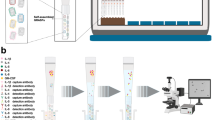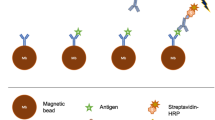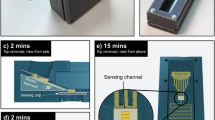Abstract
As the tissue that contains the largest representation of the human proteome1, blood is the most important fluid for clinical diagnostics2,3,4. However, although changes of plasma protein profiles reflect physiological or pathological conditions associated with many human diseases, only a handful of plasma proteins are routinely used in clinical tests. Reasons for this include the intrinsic complexity of the plasma proteome1, the heterogeneity of human diseases and the rapid degradation of proteins in sampled blood5. We report an integrated microfluidic system, the integrated blood barcode chip that can sensitively sample a large panel of protein biomarkers over broad concentration ranges and within 10 min of sample collection. It enables on-chip blood separation and rapid measurement of a panel of plasma proteins from quantities of whole blood as small as those obtained by a finger prick. Our device holds potential for inexpensive, noninvasive and informative clinical diagnoses, particularly in point-of-care settings.
This is a preview of subscription content, access via your institution
Access options
Subscribe to this journal
Receive 12 print issues and online access
$209.00 per year
only $17.42 per issue
Buy this article
- Purchase on SpringerLink
- Instant access to full article PDF
Prices may be subject to local taxes which are calculated during checkout




Similar content being viewed by others
References
Anderson, N.L. & Anderson, N.G. The human plasma proteome: history, character, and diagnostic prospects. Mol. Cell. Proteomics 1, 845–867 (2002).
Fujii, K. et al. Clinical-scale high-throughput human plasma proteome clinical analysis: Lung adenocarcinoma. Proteomics 5, 1150–1159 (2005).
Lathrop, J.T., Anderson, N.L., Anderson, N.G. & Hammond, D.J. Therapeutic potential of the plasma proteome. Curr. Opin. Mol. Ther. 5, 250–257 (2003).
Chen, J.H. et al. Plasma proteome of severe acute respiratory syndrome analyzed by two-dimensional gel electrophoresis and mass spectrometry. Proc. Natl. Acad. Sci. USA 101, 17039–17044 (2004).
Hsieh, S.Y., Chen, R.K., Pan, Y.H. & Lee, H.L. Systematical evaluation of the effects of sample collection procedures on low-molecular-weight serum/plasma proteome profiling. Proteomics 6, 3189–3198 (2006).
Sia, S.K. & Whitesides, G.M. Microfluidic devices fabricated in poly(dimethylsiloxane) for biological studies. Electrophoresis 24, 3563–3576 (2003).
Quake, S.R. & Scherer, A. From micro- to nanofabrication with soft materials. Science 290, 1536–1540 (2000).
Huang, B. et al. Counting low-copy number proteins in a single cell. Science 315, 81–84 (2007).
Ottesen, E.A., Hong, J.W., Quake, S.R. & Leadbetter, J.R. Microfluidic digital PCR enables multigene analysis of individual environmental bacteria. Science 314, 1464–1467 (2006).
Huang, L.R., Cox, E.C., Austin, R.H. & Sturm, J.C. Continuous particle separation through deterministic lateral displacement. Science 304, 987–990 (2004).
Chou, C.F. et al. Sorting biomolecules with microdevices. Electrophoresis 21, 81–90 (2000).
Toner, M. & Irimia, D. Blood-on-a-chip. Annu. Rev. Biomed. Eng. 7, 77–103 (2005).
Nagrath, S. et al. Isolation of rare circulating tumour cells in cancer patients by microchip technology. Nature 450, 1235–1239 (2007).
Yang, S., Undar, A. & Zahn, J.D. A microfluidic device for continuous, real time blood plasma separation. Lab Chip 6, 871–880 (2006).
Svanes, K. & Zweifach, B.W. Variations in small blood vessel hematocrits produced in hypothermic rates by micro-occlusion. Microvasc. Res. 1, 210–220 (1968).
Fung, Y.C. Stochastic flow in capilary blood vessels. Microvasc. Res. 5, 34–38 (1973).
Bailey, R.C., Kwong, G.A., Radu, C.G., Witte, O.N. & Heath, J.R. DNA-encoded antibody libraries: a unified platform for multiplexed cell sorting and detection of genes and proteins. J. Am. Chem. Soc. 129, 1959–1967 (2007).
Boozer, C., Ladd, J., Chen, S.F. & Jiang, S.T. DNA-directed protein immobilization for simultaneous detection of multiple analytes by surface plasmon resonance biosensor. Anal. Chem. 78, 1515–1519 (2006).
Niemeyer, C.M. Functional devices from DNA and proteins. Nano Today 2, 42–52 (2007).
Pirrung, M.C. How to make a DNA chip. Angewandte Chemie-International Edition 41, 1276–1289 (2002).
Coussens, L.M. & Werb, Z. Inflammation and cancer. Nature 420, 860–867 (2002).
Lin, W.W. & Karin, M. A cytokine-mediated link between innate immunity, inflammation, and cancer. J. Clin. Invest. 117, 1175–1183 (2007).
De Marzo, A.M. et al. Inflammation in prostate carcinogenesis. Nat. Rev. Cancer 7, 256–269 (2007).
Ashton, H. & Telford, R. Smoking and carboxhemoglobin. Lancet 2, 857–858 (1973).
Chopra, V., Dinh, T.V. & Hannigan, E.V. Serum levels of interleukins, growth factors and angiogenin in patients with endometrial cancer. J. Cancer Res. Clin. Oncol. 123, 167–172 (1997).
Oncul, O., Top, C. & Cavuplu, P. Correlation of serum leptin levels with insulin sensitivity in patients with chronic hepatitis-C infection. Diabetes Care 25, 937 (2002).
Pinsky, M.R. et al. Serum cytokine levels in human septic shock: relation to multiple-system organ failure and mortality. Chest 103, 565–575 (1993).
Schweitzer, B. et al. Multiplexed protein profiling on microarrays by rolling-circle amplification. Nat. Biotechnol. 20, 359–365 (2002).
Lambeck, A.J.A. et al. Serum cytokine profiling as a diagnostic and prognostic tool in ovarian cancer: A potential role for interleukin 7. Clin. Cancer Res. 13, 2385–2391 (2007).
Gorelik, E. et al. Multiplexed immunobead-based cytokine profiling for early detection of ovarian cancer. Cancer Epidemiol. Biomarkers Prev. 14, 981–987 (2005).
Heath, J.R. & Davis, M.E. Nanotechnology and cancer. Annu. Rev. Med. 59, 251–265 (2008).
Zimmermann, M., Delamarche, E., Wolf, M. & Hunziker, P. Modeling and optimization of high-sensitivity, low-volume microfluidic-based surface immunoassays. Biomed. Microdevices 7, 99–110 (2005).
Eisen, M.B., Spellman, P.T., Brown, P.O. & Botstein, D. Cluster analysis and display of genome-wide expression patterns. Proc. Nat. Acad. Sci. USA 95, 14863–14868 (1998).
Acknowledgements
The authors thank Larry Nagahara and Chris McLeland at the National Cancer Institute (NCI) for providing standard hCG serum samples and requesting the independent hCG measurement. We also thank Bruz Marzolf at the Institute for Systems Biology (Seattle) for printing DNA microarrays, and the UCLA nanolab for photomask fabrication. This work was funded by the National Cancer Institute grant no. 5U54 CA119347 (J.R.H., P.I.) and by the Institute for Collaborative Biotechnologies through grant DAAD19-03-D-0004 from the US Army Research Office.
Author information
Authors and Affiliations
Contributions
R.F. developed and validated the DEAL barcode assay, measured cancer patient serum samples and analyzed all data. O.V. and B.K.H.Y. developed the blood separation chip. O.V., A.S. and L.Q. performed finger-prick blood test. R.F., O.V., A.S., H.A., G.A.K., C.-C.L. and J.G. participated in the synthesis and validation of reagents and the patterning of DNA barcode microarrays. L.H. and J.R.H. designed and directed the project.
Corresponding author
Ethics declarations
Competing interests
J.R.H. and L.H. are co-founders of Integrated Diagnostics, a company that has acquired the rights to license certain of the technologies described in this paper.
Supplementary information
Supplementary Text and Figures
Figures 1–13, Tables 1–3 (PDF 15420 kb)
Supplementary Video
This movie shows on-chip plasma separation by exploiting the Zweifach-Fung effect of highly polarized blood cell flow at branch points of small blood vessels. It is executed by flowing blood through the vertical primary channel that has high-resistance, centimeter-long channels branching off perpendicularly. As the resistance ratio is increased between the branches and the primary channel, a critical streamline moves closer to the primary channel wall adjoining the branch channels. Blood cells with a radius larger than the distance between this critical streamline and the primary channel wall are directed away from the high-resistance channels, and ∼15% of the plasma is skimmed into the high-resistance channels. The remaining whole blood is directed towards a waste outlet. (WMV 2099 kb)
Rights and permissions
About this article
Cite this article
Fan, R., Vermesh, O., Srivastava, A. et al. Integrated barcode chips for rapid, multiplexed analysis of proteins in microliter quantities of blood. Nat Biotechnol 26, 1373–1378 (2008). https://doi.org/10.1038/nbt.1507
Received:
Accepted:
Published:
Issue Date:
DOI: https://doi.org/10.1038/nbt.1507



